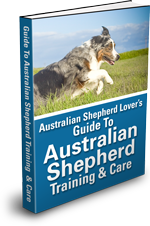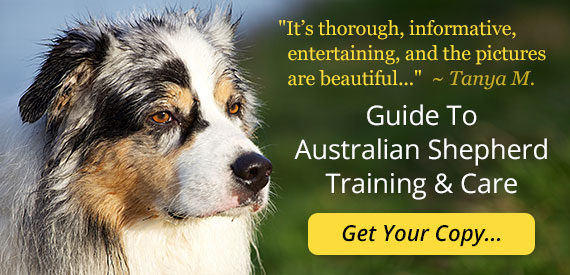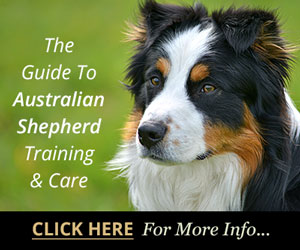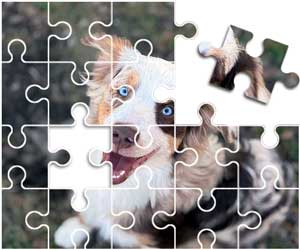
Australian Shepherd Hereditary Diseases
Arthritis in Dogs and Dog Joint
Pain
Cataracts
Iris Coloboma
Collie Eye Anomaly
Persistent Pupillary Membranes
Distichaisis
Epilepsy
Hip Dysplasia
Autoimmune Diseases
Allergies
Cancer
Retained Testicles
Dental Faults
Patent Ductus Arteriosus
Patellar Luxation
Homozygous Merle (Lethal
White)
Double Merle Aussies
Diabetes in Dogs
Epilepsy in Dogs
Genetic or hereditary diseases can have an enormous impact. Some affect the quality of life from birth while others do not manifest themselves until later in life. Although it may not be possible to completely eliminate the possibility of hereditary diseases there is a way to reduce their likelihood.
Choosing a reputable breeder is your best assurance of getting a healthy puppy. Even puppies from breeders are likely to inherit genetic problems but breeders are actively engaged in identifying and eliminating these factors from their lines giving you the best possible starting point for a healthy pet.
So, what are the main hereditary diseases that affect the Australian Shepherd breed specifically?
Cataracts
Australian Shepherds are known to frequently suffer from cataracts. Although not all cataracts are due to hereditary factors this is often the case, especially if both eyes are effected. Signs usually appear between 2-3 years but can show up as early as 1 year or as late as 7-8 years of age. Early detection and treatment is best. Cataracts can be described as an opacity that develops in the lens of the eye that results in reduced vision and if left unchecked can result in blindness.
A diagnosis of cataracts should be registered with the Canine Eye Registration Foundation (CERF).
Iris Coloboma
Another hereditary eye disorder seen in Australian Shepherds is iris coloboma. Described as a gap or hole in the formation of one of the structures of the eye. (ie. lens, retina, iris etc.) This condition can cause discomfort for the dog in bright light. There have been an increase in the number of incidents as it has not been considered a serious condition by breeders. This is changing as its prevalence has increased. Iris coloboma usually occurs in merles.
Collie Eye Anomaly
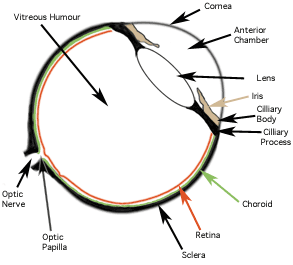 |
|
© Katriona Stitt The
canine eye, cross section |
This hereditary defect, as its name suggests, affects many of the Collie breeds: Smooth and Rough Collies, Shetland Sheepdogs, Border Collies, Lancashire Heelers, Nova Scotia Duck Tolling Retrievers and of course Australian Shepherds.
In animals with CEA, there are abnormalities of the choroid and may also be changes in the sclera. The major change, which is present in all dogs with CEA, is 'choroidal hypoplasia', a pale patch in the back of the eye caused by abnormal development of the choroid layer. Affected dogs may also have abnormalities in the sclera, producing pits or 'colobomas' in or around the optic disk.
~ CollieEye.Org
This hereditary condition needs to be diagnosed very early, before 8 weeks, due to a phenomenon known as "go normal" wherein the defect becomes impossible to detect as the eye develops. The problem however still exists and as a result any puppy diagnosed with this condition should not be used for breeding.
For more information on the Collie Eye Anomaly see CollieEye.Org.
Persistent Pupillary Membranes
The pupillary membrane covers the eye before birth and functions to supply blood to the developing lens. This membrane is usually absorbed into the eye before four or five weeks of age. The failure of this membrane to fully absorb is called a persistent pupillary membrane. Consequences range from mild to severe visual deficits including blindness. This condition can improve with age but doesn't disappear completely and can result in cataracts and damage to the cornea.
Distichaisis
Distichaisis is a hereditary condition where eyelashes grow toward the eyes instead of away. This can be very uncomfortable even painful for the dog. This can require surgical treatment before severe damage to the cornea occurs.
Epilepsy
This disease can be particularly disturbing for owners. I know because Levi developed epilepsy and has had it since he was about 2 years old. Most dogs are diagnosed between 1 and 3 years. Some dogs, like Levi, are able to keep the seizures under control with medication. He almost never has them and if he does they are very mild. Others are not so fortunate and the condition can prove fatal.
There are various reasons for why seizures may be occuring so diagnosis should be made by your veterinarian. This is a lifelong condition and any medication will have to be taken from when they are diagnosed. Yearly blood tests may be required to ensure that there are proper levels of medication.
As this condition is inherited, dogs diagnosed with epilepsy should not be used for breeding.
See Also:
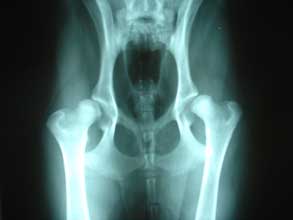 |
|
| Joel
Mills - Creative Commons License
Bilateral
hip dysplasia |
Hip Dysplasia
Hip Dysplasia is a painful condition affecting the hip joints resulting in lameness and arthritis. Although it is hereditary, environmental factors play a role in its development.
In dysplasia the caput (round head of the femur bone) no longer fits snugly into the acetabulum (concave socket in the pelvis). Additionally these two elements, the caput and acetabulum are ill formed and don't move smoothly. This results in undue wear and tear on the joints resulting in the body trying to repair damage by creating cartilage. The body cannot keep up with the rate of degradation and becomes inflammed which contributes to further damage.
As this cycle progresses the dog will become increasingly uncomfortable, eventually being rendered lame due to the intensity of the pain. Signs of this condition will be the dog attempting to restrict movement of their hips, running will appear stilted. This compensation to avoid using the hips can result in spinal or soft tissue problems developing. Hip dysplasia can be anywhere from mild to debilitatingly severe.
Autoimmune Diseases
According to the Australian Shepherd Health & Genetics Institute (ASHGI) "this class of diseases has come out of nowhere for Aussies over the past decade. They are considered as a class because individuals suffering from one may develop others and it is not unusual to have different autoimmune diseases occur in a single family. The ones most frequently encountered in Aussies are thyroiditis, lupus (discoid and erythmatosus) and generalized demodetic mange. There is a genetic pre-disposition toward these diseases, but actual illness is precipitated by an environmental trigger."
Allergies
Although environmental factors contribute largely to the development of allergies is is believed that this occurs due to a genetic predisposition. It may be tempting to diagnose allergies yourself as most of us are familiar with the symptoms but it would be better to leave that to your veterinarian.
Cancer
Cancer occurs in sufficient numbers in Australian Shepherds to be of concern. Although it is diagnosed more frequently in elderly dogs it also develops in younger ones. Environmental factors, as with allergies, play a large role and cancer is not always directly related to hereditary influence.
Retained Testicles
Retained or undecended testicles referred to in medical terminology as cryptotorchidism (crypto meaning hidden) is relatively common in Australian Shepherds. One or both testes fail to move or "decend" from the abdominal region into the scrotum. This can occur after birth but dogs whos testes have not decended by eight weeks are diagnosed with cryptotorchidism. There is a high rate of testicular cancer with these dogs and as this is genetically inherited they should not be bred.
Dental Faults
Although it generally does not cause problems for the dog, dental faults such as missing teeth or over, under and cross bites are considered a genetic defect for purposes of conformation. Breeders should take note of this characteristic and not use dogs with this defect in their breeding programs.
Patent Ductus Arteriosus
In cases of Patent Ductus Arteriosus there is an abnormal flow of blood between the aorta and pulmonary artery. Before birth these arteries are connected by the ductus arteriosus blood vessel and is a normal part of fetal circulation. However, after birth this vessel is supposed to close, but in some puppies it remains open (patent).
This condition puts a strain on the heart and increases blood pressure to the lung arteries. If a heart murmur continues to be detected in puppies older than four months they should be checked by your veterinarian for patent ductus arteriosus. Although this is a potentially lethal condition surgery has been very successful, in fact some dogs do quite with without any treatment whatsoever.
Patellar Luxation
Common to small or miniature breeds patellar luxation can also be a problem for Aussies. Patellar luxation is where the patella or kneecap moves (dislocates) out of its normal position. It is thought to be a congenital defect but can also arise as a result of blunt force injury. When it is hereditary it usually affects both sides (bilateral) of the rear legs.
This list provides some of the more common hereditary ailments that affect Australian Shepherds, but is not exhaustive. It is important to remember the importance of controlling the spread of these defects in Aussies. Breeding is a complex science requiring a blend of genetics, accurate family records, and a sincere love for the breed. This is why it is so important to only buy your Australian Shepherd from a reputable breeder.
For further information:
Australian Shepherd Health & Genetics Institute (ASHGI)
Canine Eye Registration Foundation (CERF)
Orthopedic Foundation for Animals (OFA)
Have Dog Training Questions?
Check out these introductory dog training videos...
I want my dog to stop being aggressive.
I want some help training my new puppy.
I want my dog to stop barking at everything.
Get Australian Shepherd Info, Website Updates, Special Offers, and Cartoons...
FREE GIFT
You'll also receive a free copy of the ebook
My Everyday Dog Training Tools
by professional dog trainer Daniel Abdelnoor, "Doggy Dan"
